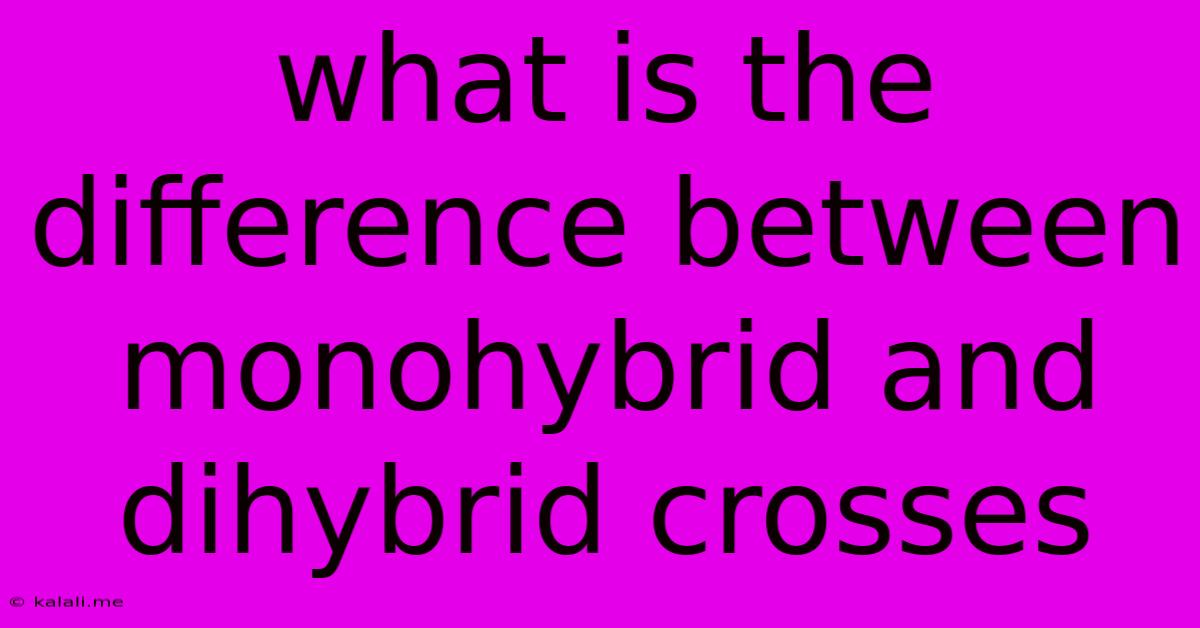What Is The Difference Between Monohybrid And Dihybrid Crosses
Kalali
Jun 16, 2025 · 3 min read

Table of Contents
Understanding the Difference Between Monohybrid and Dihybrid Crosses
Understanding Mendelian genetics is crucial for anyone studying biology, and a key concept within this field is the difference between monohybrid and dihybrid crosses. This article will clearly explain these two types of crosses, highlighting their key differences and providing examples to solidify your understanding. We'll delve into Punnett squares and phenotype ratios to illustrate the principles involved.
What is a Monohybrid Cross?
A monohybrid cross involves breeding two organisms that differ in only one trait. This single trait is determined by a single gene with two contrasting alleles – one dominant and one recessive. The purpose of a monohybrid cross is to determine the probability of offspring inheriting a specific allele combination for that single trait.
Example: Let's consider flower color in pea plants. Assume "P" represents the dominant allele for purple flowers, and "p" represents the recessive allele for white flowers. A monohybrid cross would involve crossing a homozygous dominant (PP) plant with a homozygous recessive (pp) plant, or a homozygous dominant (PP) with a heterozygous (Pp) plant, or even two heterozygous (Pp) plants.
Punnett Square for a Monohybrid Cross (Pp x Pp):
| P | p | |
|---|---|---|
| P | PP | Pp |
| p | Pp | pp |
This Punnett square shows the potential genotypes of the offspring. The phenotype ratio for this cross is typically 3:1 (3 purple-flowered plants : 1 white-flowered plant). This is because only the "pp" genotype results in white flowers; all other genotypes (PP and Pp) result in purple flowers due to the dominance of the "P" allele.
What is a Dihybrid Cross?
A dihybrid cross, on the other hand, involves breeding two organisms that differ in two traits. Each of these traits is determined by a separate gene, each with two alleles. The goal is to determine the probability of offspring inheriting specific allele combinations for both traits simultaneously.
Example: Let's continue with pea plants. Now, consider both flower color (P=purple, p=white) and plant height (T=tall, t=short). A dihybrid cross might involve crossing a plant homozygous dominant for both traits (PPTT) with a plant homozygous recessive for both traits (pptt), or crossing two heterozygous plants (PpTt x PpTt).
Punnett Square for a Dihybrid Cross (PpTt x PpTt): (A full 16-square Punnett square would be shown here, but due to formatting limitations, a simplified explanation is provided)
A dihybrid cross results in a much larger Punnett square (16 squares) compared to a monohybrid cross. Analyzing this square reveals the phenotypic ratio, typically a 9:3:3:1 ratio. This represents:
- 9 plants with purple flowers and tall stems
- 3 plants with purple flowers and short stems
- 3 plants with white flowers and tall stems
- 1 plant with white flowers and short stems
This ratio arises from the independent assortment of alleles during gamete formation, a key principle of Mendelian genetics. Each trait is inherited independently of the other.
Key Differences Summarized:
| Feature | Monohybrid Cross | Dihybrid Cross |
|---|---|---|
| Number of Traits | One | Two |
| Number of Genes | One | Two |
| Punnett Square | 4 squares (for homozygous x heterozygous), or 9 squares for heterozygous x heterozygous | 16 squares (for heterozygous x heterozygous) |
| Phenotype Ratio | Typically 3:1 (for heterozygous x heterozygous) | Typically 9:3:3:1 (for heterozygous x heterozygous) |
Understanding the distinction between monohybrid and dihybrid crosses is fundamental to grasping the principles of inheritance and predicting the genetic makeup and characteristics of offspring. While the Punnett squares can seem complex, the underlying concepts of allele dominance and independent assortment are relatively straightforward. Mastering these concepts opens the door to understanding more complex genetic scenarios.
Latest Posts
Latest Posts
-
General Who Defeated Napoleon At Waterloo
Jun 16, 2025
-
What Is The Final Step In The Research Process
Jun 16, 2025
-
University Of Las Vegas Gpa Requirements
Jun 16, 2025
-
What Are The Difference Between Entrepreneur And Entrepreneurship
Jun 16, 2025
-
What Is The Prime Factorization Of 68
Jun 16, 2025
Related Post
Thank you for visiting our website which covers about What Is The Difference Between Monohybrid And Dihybrid Crosses . We hope the information provided has been useful to you. Feel free to contact us if you have any questions or need further assistance. See you next time and don't miss to bookmark.